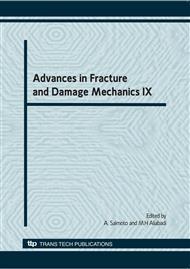p.609
p.613
p.617
p.621
p.625
p.629
p.633
p.637
p.641
Analysis of Crack-Tip Field of Particulate-Reinforced Composites Taking Account of Particle Size Effect and Debonding Damage
Abstract:
This paper deals with an analysis of a crack-tip field of particulate-reinforced composites which can describe the evolution of debonding damage, matrix plasticity and particle size effect on deformation and damage. Numerical analyses were carried out on a crack-tip field in elastic-plastic matrix composites reinforced with elastic particles by using a finite element method developed based on an incremental damage theory. The particle size effect on damage is described by a critical energy criterion for particle-matrix interfacial debonding. The effect of debonding damage on a crack-tip field is discussed based on numerical results. The debonding damage initiates and progresses ahead of a crack-tip. The stress distribution shifts downward in the debonding damage area. It is concluded that a crack-tip field is strongly affected by debonding damage.
Info:
Periodical:
Pages:
625-628
Citation:
Online since:
November 2010
Authors:
Price:
Сopyright:
© 2011 Trans Tech Publications Ltd. All Rights Reserved
Share:
Citation:


